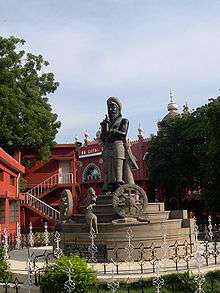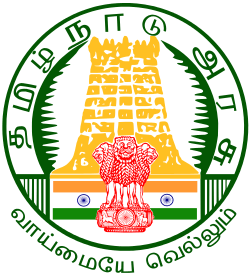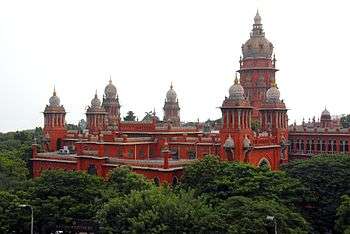Madras High Court
Coordinates: 13°05′16″N 80°17′17″E / 13.08778°N 80.28812°E
| Madras High Court | |
|---|---|
| சென்னை உயர் நீதிமன்றம் | |
|
High Court Building | |
| Established | 1862 |
| Country |
|
| Location |
Chennai (Principal Seat) Madurai (circuit bench) |
| Composition method | Presidential with confirmation of Chief Justice of India and Governor of respective state. |
| Authorized by | Constitution of India |
| Decisions are appealed to | Supreme Court of India |
| Judge term length | mandatory retirement by age of 62 |
| No. of positions | 74 |
| Website | Madras High Court |
| Chief Justice | |
| Currently | Indira Banerjee |
| Since | 16 February 2017 |
The Madras High Court is the high court of the Indian state of Tamil Nadu. The court is one of the three High Courts in India established in the three Presidency Towns of Bombay, Calcutta and Madras by Letters patent granted by Her Majesty Queen Victoria, bearing date 26 June 1862. It exercises original jurisdiction over the city of Chennai and appellate jurisdiction over the entire state of Tamil Nadu and Union territory of Puducherry, as well as extraordinary original jurisdiction, civil and criminal, under the Letters Patent and special original jurisdiction for the issue of writs under the Constitution of India.[1][2]
It consists of 74 judges and a chief justice who are in charge of the general policy adopted in the administration of justice.[2] In September 2016, the centre government forwarded names of 15 new judges to the President for his signature on their warrants of appointment. Of the 15, nine are from among lawyers and six from the subordinate judiciary.[3] The current Chief justice Of Madras High Court is Indira Banerjee .She was sworn in on 5 April 2017.
History
From 1817 to 1862, the Supreme Court of Madras, the precursor to the present Madras High Court, was situated in a building opposite the Chennai Beach railway station. From 1862 to 1892, the High Court was also housed in that building. The present buildings were officially inaugurated on 12 July 1892, when the then Madras Governor, Beilby, Baron Wenlock, handed over the key to the then Chief Justice Sir Arthur Collins.[4]

British India's three presidency towns of Madras (Chennai), Bombay (Mumbai), and Calcutta (Kolkata) were each granted a High Court by letters patent dated 26 June 1862.[5] The letters patent were issued by Queen Victoria under the authority of the British parliament's Indian High Courts Act 1861. The three courts remain unique in modern India, having been established under British royal charter; this is in contrast with the country's other high courts, which have been directly established under the Indian Constitution. However, the Constitution of India recognises the status of the older courts.
The Madras High Court was formed by merging the Supreme Court of Judicature at Madras, and the Sudder Dewanny Adawlut. The Court was required to decide cases in accordance with justice, equity and good conscience. The earliest judges of the High Court included Judges Holloway, Innes and Morgan. The first Indian to sit as a judge of the High Court was Justice T. Muthuswamy Iyer. Other early Indian judges included Justices V. Krishnaswamy Iyer and P. R. Sundaram Iyer.
The Madras High Court was a pioneer in Original Side jurisdiction reform in favour of Indian practitioners as early as the 1870s.
The Madras High Court's history means that the decisions of the British Judicial Committee of the Privy Council are still binding on it, provided that the ratio of a case has not been over-ruled by the Supreme Court of India.
Although the name of the city was changed from Madras to Chennai in 1996, the Court as an institution did not follow suit, and retained the name as the Madras High Court. However, a Bill to rename the Madras High Court as the Chennai High Court was approved by the cabinet on 5 July 2016, along with the change of name of the Calcutta High Court and Bombay High Court as Kolkata High Court and Mumbai High Court respectively.[6] The Bill called High Courts (Alternation of Names) Bill has been introduced in the Lok Sabha on 19 July 2016.[7] The Bill is yet to be passed by both Houses of Parliament. However, the Tamil Nadu Legislative Assembly has passed a unanimous resolution appealing to the Central Government to rename the court as High Court of Tamil Nadu since the Court serves the whole state.[8]
Building Complex
The building of the High Court, an exquisite example of Indo-Saracenic style of architecture, was built in 1892 with the design prepared by J.W. Brassington and later under the guidance of the famed architect Henry Irwin,[9] who completed it with the assistance of J.H. Stephens. The High Court building was damaged in the shelling of Madras by S.M.S. Emden on 22 September 1914, at the beginning of the First World War. It remains one of the very few Indian buildings to have been damaged by a German attack.
There are several matters of architectural interest in the High Court. The painted ceilings and the stained glass doors are masterpieces in themselves. The old lighthouse of the city is housed within the High Court campus, but is unfortunately poorly maintained and is in disrepair.
The Department of Posts has allotted a Postal Index Number (PIN) code of 600 104 to the zone occupied by the Madras High Court. The boundaries of the High Court complex are marked by two roads, namely, Prakasam Road (formerly Broadway) and Rajaji Road (the old North Beach Road), stretching northward from the statue of Rajaji in the northeast and the statue of T. Prakasamgaru in the southwest within the complex. The complex houses the largest number of courts in Asia.[10]

Bench
The current Chief Justice of the Madras High Court is Hon'ble Ms. Justice Indira Banerjee. it currently has 48 judges, including the Chief Justice, who exercise civil, criminal, writ, testamentary and admiralty jurisdiction.[11] The Madurai Bench has been functioning since 2004.
The vestiges of the colonial High Court continue to characterise the premises till date. In a rare tradition which is today a distinction, Judges of the Madras High Court are still led by orderlies who bear a ceremonial mace made of silver. This is a practice so old and Anglican that most High Courts and even the Supreme Court of India have either not had the practice at all or have abandoned it long back.[12] 1569)
Reporting - Madras Law Journal (since 1891)
The Madras High Court is the birthplace of organised legal reporting in India. It is home to the Madras Law Journal.,[13] which was the first journal dedicated to reporting texts of judgments of the High Court started way back in 1891.

An informal eponymous club called The Saturday Club, that met at 11 a. m. every week, was started at the house of the Vakil Bar's senior member Sir S. Subramania Iyer in Mylapore in 1888 with all leading members of the Madras Bar taking part. At one of these meetings it was decided to start 'The Madras Law Journal', which was inspired by the then newly established periodicals like 'Law Quarterly Review', started by Sir Frederick Pollock in England in 1885 and 'The Harvard Law Review' established by Harvard Law School Association in 1887.
The objectives of the journal were laid out in the preface of the first issue: "In addition to giving our own reports of the decisions of the High Courts in Madras and other places, we hope to place before our readers translations of various Hindu Law Books which remain yet untranslated, insofar as they have bearing on questions which practically arise for decision every day in our Courts of Justice. We propose further from time to time, to place side by side the conflicting decisions of the various Courts in India on the same point in the hope that such procedure will enable the Courts to act in greater harmony than they do at present in the interpretation of Acts and enunciation of general principles of law and when this is not possible, to enable the Legislature to bring about such harmony by removing the ambiguities which may have given rise to such discordant views."
Right from the beginning, The Madras Law Journal has been a source of inspiration and instruction to the students of law and its notes and editorial reviews always evoked admiration and respect. It achieved well-deserved fame throughout India, in England and America and indeed throughout the British Empire for its quickness and accuracy in reporting and discrimination in the selection of cases to be reported. It has now came to occupy a premier place among legal periodicals in the country and its weight and authority have been consistently considerable with the Bench and the Bar in all parts of India.
Reporting - Madras Weekly Notes (Criminal and Civil) Since 1910 :-
Madras Weekly Notes is a Law Journal reporting the Criminal Side Judgements of the Hon'ble Madras High Court from 1910 to till date.
Mode of Citation : 1929 1 MWN(Cr.) 1 which means <Year> <Volume> <Journal Name> <Page Number>
Law Journals Reporting Judgements of the Hon'ble Madras High Court:-
CTC - Current TamilNadu Cases. CWC - Current Writ Cases. TNMAC - TamilNadu Motor Accident Cases.
Madurai Bench
Established in 2004, the court is a boon to the people in thirteen southern districts of Tamil Nadu. The bench has Kanyakumari, Tirunelveli, Tuticorin, Madurai, Dindigul, Ramanathapuram, Virudhunagar, Theni, Sivaganga, Pudukottai, Tanjore, Tiruchi and Karur districts under its jurisdiction.
The sprawling 107-acre campus is one of the largest court campuses in the country and the spacious four-storey administrative building attracts hundreds of litigants every day. The court complex has 12 court halls, furnished on the model of the court halls in the Supreme Court, the Delhi and the Madras High Courts.
The court, since its inauguration on 24 July 2004, has perked up the legal process in the southern districts and has cultivated a large number of social activists, who vouch for the interest of the public though their public interest litigations.[14]
List of Chief Justices

Supreme Court
| Chief Justice | Term |
|---|---|
| Sir Thomas Andrew Lumisden Strange | 1801–1816 |
| Sir John Henry Newbolt | 1816–1820 |
| Sir Edmond Stanley | 1820–1825 |
| Sir Ralph Palmer | 1825–1835 |
| Sir Robert Buckley Comyn | 1835–1842 |
| Sir Edward John Gambier | 1842–1850 |
| Sir Christopher Rawlinson | 1850–1859 |
| Sir Henry Davison | 1859–1860 |
| Sir Colley Harman Scotland | 1860–1861 |
High Court (British Administration)
| Chief Justice | Term |
|---|---|
| Sir Colley Harman Scotland | 1861–1871 |
| Sir Adam Bittleston | 1866–1867 (acting) |
| Sir Walter Morgan | 1871–1879 |
| Sir Charles Arthur Turner | 1879–1885 |
| Sir Arthur John Hammond Collins | 1885–1898 |
| Charles Arnold White | 1899–1914 |
| John Edward Power Wallis | 1914–1921 |
| Sir Walter George Salis Schwabe | 1921–1924 |
| Sir Murray Coutts-Tratter | 1924–1929 |
| Sir Horace Owen Compton Beasley | 1929–1937 |
| Sir Alfred Henry Lionel Leach | 1937–1947 |
| Sir Frederick William Gentle | 1947–1948 |
High Court (Indian Administration)
| This article is part of a series on |
| Government and Politics of Tamil Nadu |
|---|
 |
|
State of Tamil Nadu தமிழ்நாடு மாநிலம் |
|
| Chief Justice | Term |
|---|---|
| Justice P. V. Rajamannar | 1948 – 10 May 1961 |
| Justice S. Ramachandra Iyer | 10 May 1961 – 23 November 1964 |
| Justice Palagani Chandra Reddy | 23 November 1964 – 1 July 1966 |
| Justice M. Anantanarayanan | 1 July 1966 – 1 May 1969 |
| Justice Kuppuswami Naidu Veeraswami | 1 May 1969 – 8 April 1976 |
| Justice Palapatti Sadaya Goundar Kailasam | 8 April 1976 – 3 January 1977 |
| Justice Padmanabhapillay Govindan Nair | 3 January 1977 – 29 May 1978 |
| Justice Tayi Ramaprasada Rao | 29 May 1978 – 6 November 1979 |
| Justice Muhammad Kassim Muhammad Ismail | 6 November 1979 – 12 March 1982 |
| Justice Krishna Ballabh Narayan Singh | 12 March 1982 – 2 April 1984 |
| Justice Madhukar Narhar Chandurkar | 2 April 1984 – 19 October 1989 |
| Justice Adarsh Sein Anand | 1 November 1989 – 16 June 1992 |
| Justice Kanta Kumari Bhatnagar | 15 June 1992 – 1 July 1993 |
| Justice Kudarikoti Annadanayya Swamy | 1 July 1993 – 7 July 1997 |
| Justice Manmohan Singh Liberhan | 7 July 1997 – 25 May 1999 |
| Justice Ashok Chhotelal Agarwal | 24 May – 9 September 1999 |
| Justice Konakuppakattil Gopinathan Balakrishnan | 9 September 1999 – 13 September 2000 |
| Justice Nagendra Kumar Jain | 13 January 2000 – 12 September 2001 |
| Justice B. Subhashan Reddy | 12 September 2001 – 28 November 2004 |
| Justice Markandey Katju | 28 November 2004 – 12 November 2005 |
| Justice Ajit Prakash Shah | 12 November 2005 – 11 May 2008 |
| Justice Asok Kumar Ganguly | 21 May 2008 – 9 March 2009[15] |
| Justice Hemant Laxman Gokhale | 9 March 2009 – 10 June 2010 |
| Justice M Y Iqbal | 11 June 2010 – 6 February 2013 |
| Justice Rajesh Kumar Agrawal | 7 February 2013 – 23 October 2013 (Acting) 24 October 2013 – 12 February 2014 (Acting) |
| Justice Satish K Agnihotri | 13 February 2014 – 25 July 2014 (Acting) [16] |
| Justice Sanjay Kishan Kaul | 26 July 2014 – 15 February 2017 [17] |
| Justice Huluvadi G Ramesh | 16 February 2017 - 4 April 2017 |
| Justice Indira Banerjee | 5 April 2017- |
See also
References
- ↑ "Madras High Court". BSNL. Retrieved 2 March 2012.
- 1 2 "History of Madras High Court". Madras High Court. Retrieved 25 April 2014.
- ↑ "High Court to get 15 new judges next week". thehindu.com. Retrieved 9 May 2017.
- ↑ Sangameswaran, K. T.; Vivek Narayanan (8 June 2014). "Madras High Court buildings to undergo repairs soon". The Hindu. Chennai: The Hindu. Retrieved 22 June 2014.
- ↑ "Madras High Court". www.hcmadras.tn.nic.in. Retrieved 9 May 2017.
- ↑ "Cabinet renames high courts in Kolkata, Mumbai, Chennai". indianexpress.com. 5 July 2016. Retrieved 9 May 2017.
- ↑ PTI. "Govt. moves Bill to change names of High Courts". thehindu.com. Retrieved 9 May 2017.
- ↑ "Rename Madras high court as Tamil Nadu HC and not as Chennai HC, resolution passed by TN assembly says - Times of India". indiatimes.com. Retrieved 9 May 2017.
- ↑ "Restoring the old Article from NewIndPress news website". newindpress.com. Retrieved 9 May 2017.
- ↑ Chandru, K. (26 November 2011). "Some thoughts around the Madras High Court". The Hindu. Chennai: The Hindu. Retrieved 27 November 2011.
- ↑ http://www.hcmadras.tn.nic.in/prejudge.htm
- ↑ "Lordships cling to colonial mace". The Hindu. 7 February 2013. ISSN 0971-751X. Retrieved 14 June 2016.
- ↑ Archived 13 December 2007 at the Wayback Machine.
- ↑ "The 'green bench' that has delivered landmark judgements". The Hindu.
- ↑ "Justice Asok Kumar Ganguly to be Chief Justice of Madras High Court". The India Post. 21 May 2008. Retrieved 26 November 2009.
- ↑ "Madras High Court". www.hcmadras.tn.nic.in. Retrieved 9 May 2017.
- ↑ "Madras High Court". www.hcmadras.tn.nic.in. Retrieved 9 May 2017.
External links
- Madras Law Journal (MLJ) web site (to access decisions of the Madras High Court since 1891).
- High Court of Madras web site.
